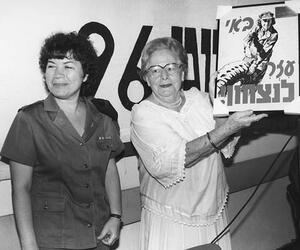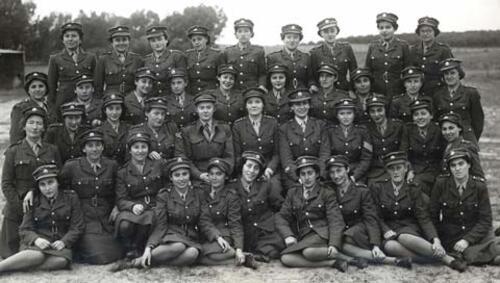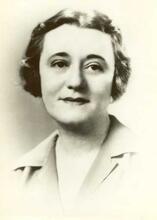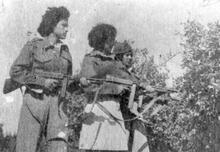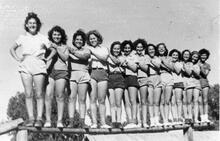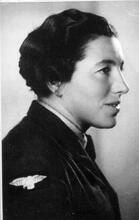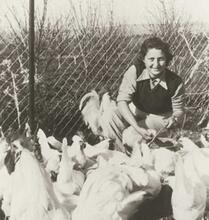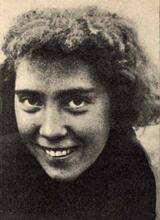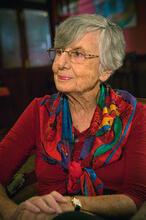ATS and WAAF in World War II
Brigadier General Israela Oron, O.C Women's Corps, and Esther Herlitz, presenter, at "Dor l'Dor Yabia Omer," a meeting held on the occasion of a visit of Women Veterans of ATS (Auxiliary Territorial Service) and WAAF (Women’s Auxiliary Air Force) to the Chen Training Camp in Sarafand, June 19, 1996.
Institution: Esther Herlitz
Thirty thousand men volunteered for the British Army between 1939 and 1946. Only when the Council of Women’s Organizations called for the recruitment of women as well was an agreement reached with the British authorities to enlist women into the forces. The first to join were a small group of sixty women to be trained as officers and N.C.O.s for the ATS (Auxiliary Territorial Service), followed by women joining the WAAF (Women’s Auxiliary Air Force). The women in ATS and WAAF were employed in a wide range of tasks, including working in arms and ammunition depots, photography, meteorological services, and driving. The experience of service in the British army was of great importance in the establishment of the IDF and the Women’s Corps.
Initiation of ATS and WAAF
The Jewish community in Palestine prior to the establishment of the State of Israel. "Old Yishuv" refers to the Jewish community prior to 1882; "New Yishuv" to that following 1882.Yishuv regarded the war against Nazi Germany (World War II) as its war. At the behest of the Jewish Agency thirty thousand men volunteered for the British Army between 1939 and 1946. Only when the Council of Women’s Organizations called for the recruitment of women as well was an agreement reached with the British authorities to enlist women into the forces. The first to join, on January 25, 1942, was a small group of sixty women to be trained as officers and N.C.O.s for the ATS (Auxiliary Territorial Service). Women for the WAAF (Women’s Auxiliary Air Force) were drafted only on May 25, 1943. The call was for women between twenty and forty-five years of age. Altogether 4,350 Palestinian women volunteers joined the British Armed Forces “for the duration of emergency.” Most were discharged in 1946.
The subject of women serving in the British army was at first controversial in the Yishuv. Questions were raised about the moral issue as well as with regard to the appropriateness of leaving the country at a time at which the German General Erwin Rommel was advancing on Egypt. Considerable effort was invested in a large-scale recruitment drive, which turned out to be successful.
Women of all walks of life and age groups, married and single, joined up. In some cases, both husband and wife joined. Some were illiterate and some were highly educated. A great many were recent young immigrants, mostly Youth Lit. "ascent." A "calling up" to the Torah during its reading in the synagogue.aliyah graduates who had no permanent homes in the country.
Basic training of a month took place in the central British military base at Sarafand in Palestine. The women were posted to sixteen ATS units in Palestine, Egypt, Syria and Lebanon. Toward the end of the war a number of ATS were sent to Italy and Austria. ATS camps were separate companies under women officers. The top echelon was entirely British; only two companies were fully under “Palestinian” command. The women’s army identification numbers ran as W/Pal and they wore the insignia “Palestine” on their sleeves.
Uniforms of the ATS were all khaki, from underwear to stockings, shirts, battle dress and skirts. Only the drivers wore trousers. The heavy material did not suit the Middle East climate. The blue WAAF uniforms were the envy of all, as were those of the United States and South African women contingents.
Tasks and Responsibilities
The ATS were employed in a great number of tasks. They did not carry arms, but worked in arms and ammunition depots and repaired various kinds of arms. The Haganah was keenly interested in these jobs since they provided vital training for later use by the Yishuv. Most of the women were storekeepers in the vast Army Ordinance Depots spread all over the Middle East. Many were drivers of heavy trucks, buses, staff cars and ambulances. They drove convoys into the Western Desert, often under aerial bombardment, as well as from Egypt through the Sinai Desert to Haifa port. Some were nursing orderlies (none were nurses), some were clerks and switchboard operators, some folded parachutes, some coded and decoded cables, some operated radar stations. The WAAF also worked in aerial photography, metereological services, spare parts, plotting, and in the operation rooms.
The ATS and WAAF officers and Other Ranks tried very hard to maintain a Jewish and Zionist atmosphere in their camps. First and foremost, they insisted on the use of Hebrew and the translation of orders and instructions into Hebrew. Attempts were made to celebrate Friday nights and Jewish holidays together with male units such as the Jewish Brigade and with Jewish soldiers from around the world. When it became possible, they undertook to extend help to Holocaust survivors, sending clothes and other gifts. Those who served in Europe helped in the Displaced Persons camps and the camp schools, and with the illegal immigration to Palestine.
It must be said that throughout their service most of the women served two masters, the British monarch and the Jewish authorities of the Yishuv. They smuggled arms and threatened to quit the armed forces when the British carried out massive searches and arrests in Palestine. The contacts the women established with Jewish communities were of great importance. In Egypt, the Jewish community ran clubs for Jewish soldiers from all over the world. The women’s organizations opened and maintained hostels for the enlisted women in Egypt, as well as children’s homes for the children of the enlisted mothers in Palestine.
Impact of ATS and WAAF
Altogether, the service in the army, though not always easy and often far away from home, was a valuable experience for most of the women . Many learned a trade, most learned the English language. They experienced the “big world,” meeting women from all walks of life and people of other nationalities. On return home after four or five years of service they were helped to readjust to civilian life; a considerable number benefitted from the British Government’s program of assistance with interrupted studies.
The experience of service in the British army was ultimately of great importance in the establishment of the Israel Defense Forces (IDF) and the Women’s Corps (“CHEN,” Heb. lit. “charm,” acronym for Hel Nashim). The first five commanding officers of the Chen had all been officers in the ATS. Most of the ATS and WAAF officers were called up for active duty in the IDF as soon as the War of Independence broke out.
A large number of lasting friendships were formed during the army service. An ongoing relationship with the young women of the Hen is maintained to the present day.
A lavishly illustrated book entitled We Volunteered for the British Army: Jewish Women from Palestine in World War II was published (in Hebrew) in 2005.

